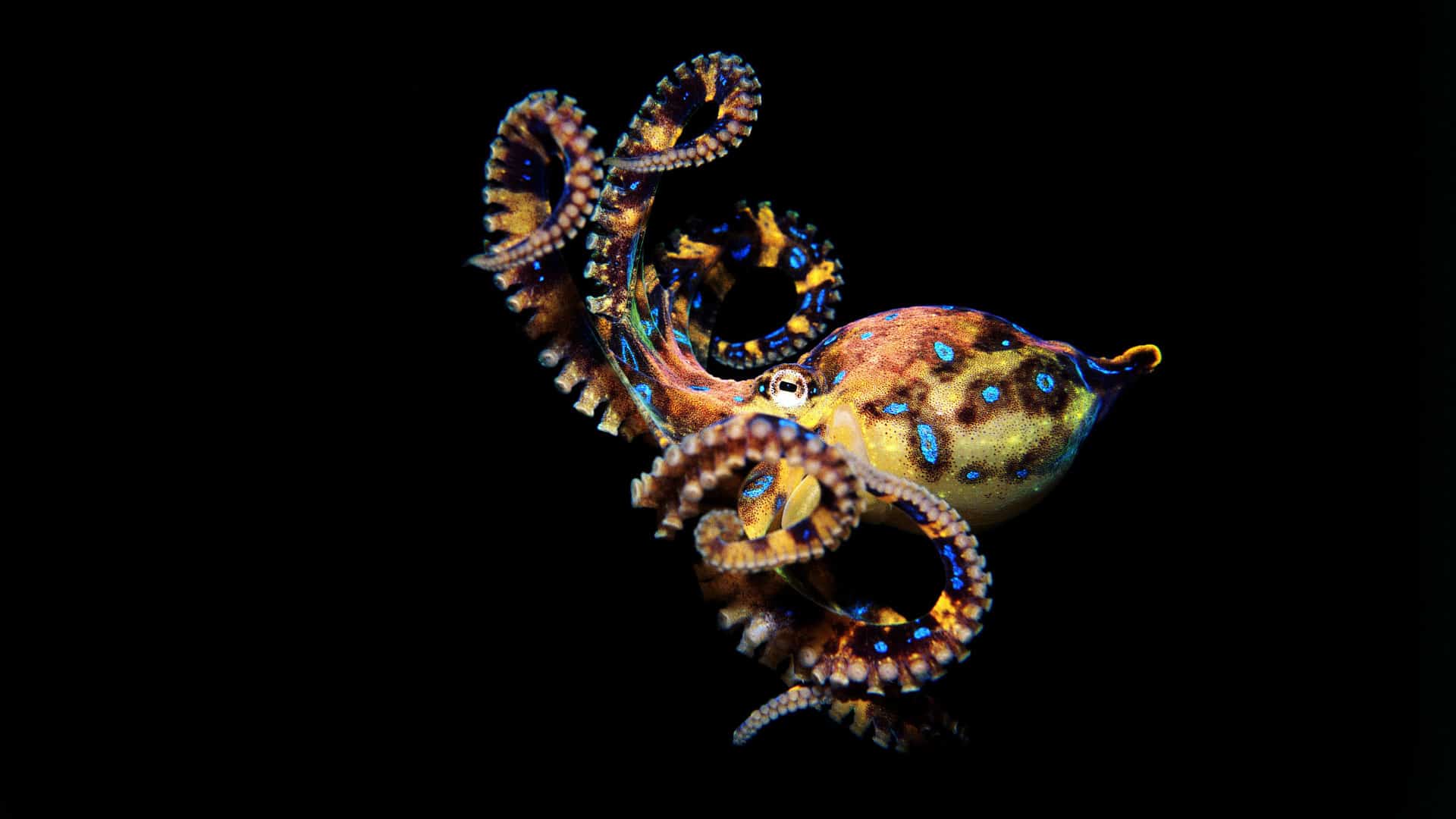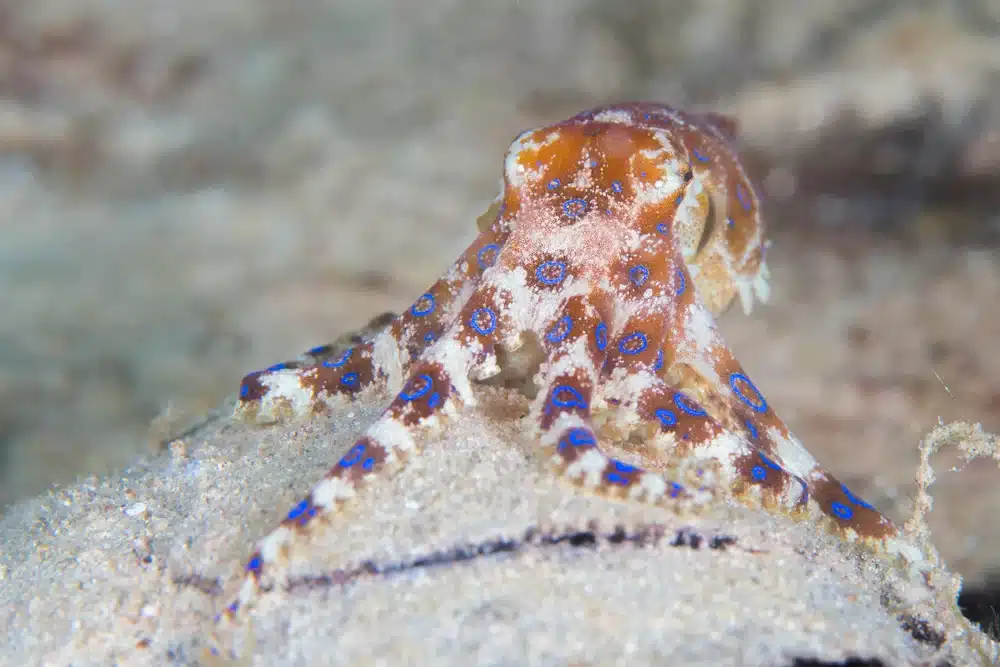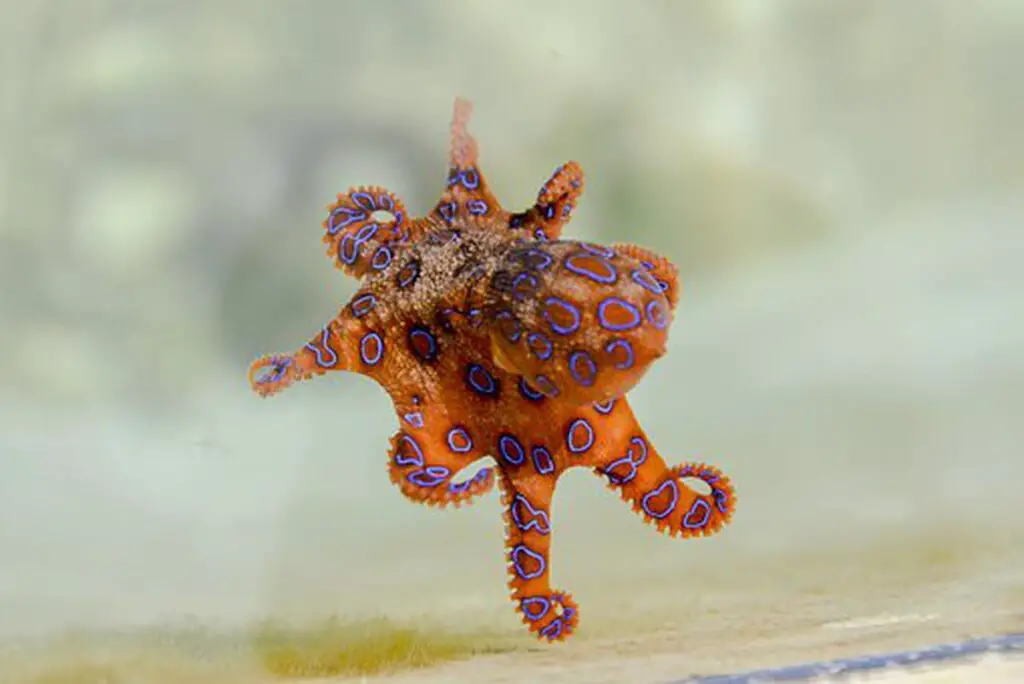Where Do Blue Ringed Octopus Live

Introduction
Where Do Blue Ringed Octopus Live: The blue-ringed octopus, a mesmerizing and enigmatic marine creature, is renowned for its stunning appearance and deadly venom. These tiny cephalopods, measuring just a few inches in size, are native to the warm coastal waters of the Indo-Pacific Ocean, making their homes in a range of captivating underwater habitats.
These remarkable creatures primarily inhabit the coral reefs that grace the tropical waters of the Indo-Pacific. The vibrant and diverse ecosystems of coral reefs provide them with an ideal environment. Blue-ringed octopuses often hide amongst the nooks and crannies of the coral, using their remarkable camouflage abilities to blend seamlessly into their surroundings. This natural camouflage helps them evade predators and hunt for their prey, which includes small crustaceans and fish.
Beyond coral reefs, blue-ringed octopuses are also found in other coastal environments such as rocky crevices and tide pools. These adaptable creatures can adjust to varying conditions, from the surge of the open ocean to the relative stability of tide pools during low tide. Their versatile habitat choices demonstrate their ability to thrive in a range of ecosystems.
While their dazzling blue rings serve as a warning of their potent venom, the habitats they call home remain a source of fascination and intrigue for marine enthusiasts and scientists alike. Exploring where these captivating creatures live provides valuable insights into their behavior, ecology, and the delicate balance of life beneath the waves in the Indo-Pacific.

Do blue-ringed octopus live in America?
World Range & Habitat
Blue-ringed octopuses, Hapalochlaena maculosa, can be found only in the temperate waters of southern Australia, from southern Western Australia to eastern Victoria at depths ranging from 0-50 m.
These fascinating and highly venomous creatures are primarily native to the warm coastal waters of the Indo-Pacific Ocean, which includes regions around Australia, Japan, the Philippines, and Southeast Asia. They are notably absent from the waters of the Americas, including North America, Central America, and South America.
The distribution of blue-ringed octopuses is largely restricted to the Indo-Pacific region due to their specific ecological and environmental requirements. They prefer tropical and subtropical waters with the right combination of temperature, salinity, and habitat features, which are commonly found in the Indo-Pacific but not in the Americas.
While the vibrant and diverse marine life in the Americas offers its own array of fascinating creatures, the blue-ringed octopus remains a unique and elusive species exclusive to the distant waters of the Indo-Pacific. It is essential to understand the geographical limitations of their habitat to appreciate the significance of their presence in their native range and the challenges they face due to habitat degradation and other threats in their natural environment.
Can you survive a blue-ringed octopus?
What Is the Prognosis for a Blue-Ringed Octopus Blue-ringed Bite? Deaths due to a blue-ringed octopus bite are extremely rare. There have only been 3 known deaths. Many more people have been bitten but survived.
Surviving a blue-ringed octopus encounter is possible, but it largely depends on several critical factors: quick recognition, prompt medical treatment, and luck. Blue-ringed octopuses are among the most venomous creatures in the world, and their bite can be life-threatening if not properly addressed.
- Recognition: The first step in surviving a blue-ringed octopus encounter is recognizing it. Blue-ringed octopuses typically display their brilliant blue rings when threatened or agitated. However, these rings are not always visible, as the octopus can quickly change color to blend into its surroundings. So, awareness and avoiding unnecessary contact are essential.
- Immediate First Aid: If bitten, it’s crucial to seek immediate medical attention. There is no known antivenom for blue-ringed octopus venom, so treatment focuses on managing symptoms. This may include wound care, pain management, and, in severe cases, respiratory support if paralysis occurs.
- Timely Medical Care: The faster medical help is sought, the better the chances of survival. The venom of the blue-ringed octopus can paralyze the respiratory muscles, leading to suffocation. Quick intervention can help mitigate these effects.
- Individual Response: The severity of a blue-ringed octopus bite can vary from person to person. Some individuals may experience more severe symptoms than others. Factors like the size of the octopus, the depth of the bite, and the amount of venom injected can all influence the outcome.
Surviving a blue-ringed octopus encounter is possible with immediate recognition, prompt medical treatment, and the extent of envenomation. However, prevention by avoiding contact with these fascinating yet dangerous creatures is the safest approach to ensure one’s well-being.
What do blue ring octopus eat?
They eat small crabs, hermit crabs, shrimp, and occasionally small fishes: however, they are primarily crab-eaters. Ambush predators, they usually pounce on their hard-shelled prey trap it with their arms and use their sharp parrot-like beak to pierce a hole in the prey’s shell or exoskeleton.
Blue-ringed octopuses are carnivorous predators with a diet primarily consisting of small marine animals. Their menu includes various prey items commonly found in their natural habitat within the coral reefs and coastal waters of the Indo-Pacific Ocean. Here’s a closer look at what blue-ringed octopuses eat:
- Crustaceans: Blue-ringed octopuses have a particular penchant for crustaceans, such as crabs and shrimp. These small crustaceans are abundant in their habitat, making them an easily accessible food source.
- Fish: These octopuses also feed on small fish. They use their impressive camouflage abilities and stealth to ambush and capture fish swimming nearby. Their powerful beaks and salivary secretions assist in breaking down and digesting fish flesh.
- Mollusks: Blue-ringed octopuses are known to consume various mollusks, including snails and bivalves. They use their sharp beaks to drill through the shells of these prey items and access the soft flesh inside.
- Worms and other invertebrates: In addition to the above, they may also feed on marine worms and other small invertebrates that they can catch.
Their hunting strategy often involves patiently waiting for prey to come close, then quickly striking with their tentacles and immobilizing it with their paralyzing venom. Blue-ringed octopuses are skilled hunters, and their diet reflects their adaptability to various prey types available in their coastal and reef environments.
Do any animals eat blue-ringed octopus?
Despite its bright coloration meant to warn predators of its venomous threat, the blue ringed octopus still has many potential predators to avoid in its environment. Eels, birds, and fish may attempt to eat the octopus but must do so using the element of surprise.
Blue-ringed octopuses, small and venomous creatures found primarily in the waters of the Pacific and Indian Oceans, are rarely preyed upon by other animals due to their potent venom and unassuming appearance. These octopuses are renowned for their stunning blue rings that appear as a warning signal when they feel threatened, but they are otherwise inconspicuous.
Their venom contains tetrodotoxin, a deadly neurotoxin that can paralyze and kill their prey within minutes. This potent defense mechanism keeps most predators at bay. However, there are a few creatures in their habitat that have developed immunity or strategies to consume them.
One example is the greater blue-ringed octopus (Hapalochlaena lunulata), which preys on smaller blue-ringed octopuses. This can lead to deadly battles between individuals of these species.
Is there a poisonous octopus?
Although all octopuses (as well as cuttlefish and some squid) are venomous, the blue-ringed octopus is in a league of its own. Its venom is 1,000 times more powerful than cyanide, and this golf-ball sized powerhouse packs enough venom to kill 26 humans within minutes.
There are several species of poisonous octopuses, with the blue-ringed octopus being one of the most notorious examples. Blue-ringed octopuses are small, highly venomous cephalopods found primarily in the waters of the Pacific and Indian Oceans. They are renowned for their striking blue and black rings, which appear as a warning signal when they feel threatened or agitated.
The venom of blue-ringed octopuses contains a potent neurotoxin called tetrodotoxin, which is also found in certain pufferfish and cone snails. Tetrodotoxin blocks sodium channels in nerve cells, leading to paralysis and, in severe cases, death. While these octopuses are not typically aggressive and prefer to hide rather than confront threats, they can deliver a potentially lethal bite if cornered or provoked.
In addition to the blue-ringed octopus, there are other octopus species that possess venom, but their toxicity varies. For instance, the greater blue-ringed octopus preys on smaller blue-ringed octopuses and can be venomous as well.
These poisonous octopuses serve as a reminder of the diverse and often deadly adaptations that have evolved in marine life. They also underscore the importance of respecting and preserving the delicate ecosystems in which these fascinating creatures reside.
Is there anti venom for blue-ringed octopus?
While there is no antivenom available for a blue-ringed octopus bite, the venom has short-lived effects (usually hours). At the end of the day, enjoy the ocean. But if you see any small octopus, whatever you do, do not pick it up.
There is an antivenom for blue-ringed octopus envenomation. The blue-ringed octopus is a highly venomous marine creature found in the coastal waters of the Pacific and Indian Oceans. Despite its small size and unassuming appearance, its venom contains potent neurotoxins that can cause paralysis and, if left untreated, lead to respiratory failure and death.
The antivenom is specifically designed to counteract the effects of the venom. It is created by injecting small, non-lethal doses of blue-ringed octopus venom into horses or other animals. The animal’s immune system responds by producing antibodies against the venom. These antibodies are then harvested and purified to create the antivenom.
In the event of a blue-ringed octopus bite, administering the antivenom promptly is crucial. It works by binding to the venom molecules, neutralizing their toxic effects, and allowing the body’s natural systems to eliminate them. However, it’s important to note that the antivenom is most effective when administered soon after the bite occurs.
What if you touch a blue-ringed octopus?
Blue-ringed octopuses can kill humans by biting and injecting venom. They bite when they feel threatened, and since we’re so much bigger than they are, humans are certainly threatening! Most small animals in the ocean that have stunning colors are toxic, or venomous.
Touching a blue-ringed octopus can be extremely dangerous and potentially lethal. These small, colorful creatures may appear harmless, but they are among the most venomous marine animals in the world. The venom of a blue-ringed octopus contains potent neurotoxins that can cause paralysis and, if not treated promptly, lead to respiratory failure and death.
If you accidentally touch a blue-ringed octopus, it’s important to seek immediate medical attention. Even a slight brush against their skin can result in envenomation. Symptoms may not be immediately apparent, but they can develop rapidly. They may include muscle weakness, difficulty breathing, vision changes, and loss of consciousness.
First aid measures typically involve immobilizing the affected limb and applying pressure to the wound site to slow the spread of venom. However, the most crucial step is receiving antivenom as soon as possible. This specialized treatment is designed to counteract the effects of the venom and must be administered promptly for the best chance of a full recovery.
It’s crucial to exercise extreme caution around any marine creature, especially those with vibrant markings like the blue-ringed octopus. Admiring them from a safe distance in their natural habitat is the best way to appreciate their beauty while ensuring your own safety.
Do blue-ringed octopus sleep?
Behavior. Blue-ringed octopuses are solitary animals that feed and sleep alone.
Blue-ringed octopuses do not have traditional sleep patterns like mammals or birds. Instead, they undergo periods of rest and inactivity, which can be considered a form of “resting state” rather than true sleep.
During these periods of rest, blue-ringed octopuses typically find a secure location, such as a crevice or hole, where they can hide and feel safe. They may also bury themselves in the sand or use their arms to create a protective shelter. In this state, their metabolic rate slows down, and they become less responsive to external stimuli. This resting behavior is important for conserving energy and avoiding potential predators.
While in this state of rest, blue-ringed octopuses remain vigilant to some degree. They have specialized cells called chromatophores that allow them to change color and patterns, which they might use to blend into their surroundings or communicate with other octopuses.
The biology and behavior of blue-ringed octopuses are not as extensively studied as some other marine creatures, so there may be aspects of their resting patterns that are not fully understood.

Conclusion
The habitat of the blue-ringed octopus in the Indo-Pacific Ocean is a testament to the remarkable adaptability of these creatures. Whether nestled within the intricate coral reefs or hidden in rocky crevices and tide pools, these cephalopods have evolved to thrive in a diverse range of underwater environments.
The blue-ringed octopus’s choice of residence within the vibrant coral reefs and along the coastal areas exemplifies the interconnectedness of marine ecosystems. These habitats not only offer shelter but also a rich source of sustenance for these creatures. By studying their habitats, researchers gain valuable insights into the intricate relationships that underpin marine life in these regions.
The fascination with the blue-ringed octopus extends beyond its habitat. Its stunning appearance and potent venom continue to captivate scientists and marine enthusiasts, sparking curiosity about these remarkable animals. The mystery of where they live is just one piece of the puzzle, and ongoing research promises to unveil more about their behavior, reproduction, and interactions with their surroundings.
Ultimately, the blue ringed octopus and its habitat serve as a poignant reminder of the intricate beauty and complexity of our oceans, emphasizing the need for conservation efforts to protect these delicate ecosystems and the incredible creatures that call them home.



